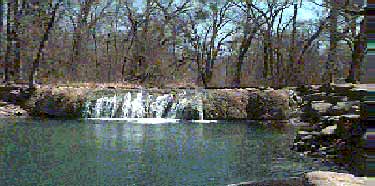Little River National Wildlife
Refuge,Cyprees Knees, FWS photo
 Ancient Cross Timbers Project: http://www.uark.edu/misc/xtimber/
The Cross Timbers are the post oak and blackjack oak woodlands that form
the western frontier of deciduous forests in Texas, Oklahoma, and
southeastern Kansas. Literally thousands of acres of ancient forest
survive in the Cross Timbers because these stout oaks were too short and
craggy for commercial sawlog production. Post oak trees up
to 400 years old and red cedar trees over 500 years old have been found
in these interesting woodlands. Unfortunately, the great antiquity of
the uncut Cross Timbers is not widely appreciated and they continue to
be destroyed. This project is dedicated to the location and
appreciation of these authentic ancient forest remnants.
Ancient Cross Timbers Project: http://www.uark.edu/misc/xtimber/
The Cross Timbers are the post oak and blackjack oak woodlands that form
the western frontier of deciduous forests in Texas, Oklahoma, and
southeastern Kansas. Literally thousands of acres of ancient forest
survive in the Cross Timbers because these stout oaks were too short and
craggy for commercial sawlog production. Post oak trees up
to 400 years old and red cedar trees over 500 years old have been found
in these interesting woodlands. Unfortunately, the great antiquity of
the uncut Cross Timbers is not widely appreciated and they continue to
be destroyed. This project is dedicated to the location and
appreciation of these authentic ancient forest remnants.
 Oklahoma's
Forests Oklahoma Department of Agriculture, Food & Forestry: Oklahoma's Forests
http://www.oda.state.ok.us/forestry-okforestshome.htm
Oklahoma's
Forests Oklahoma Department of Agriculture, Food & Forestry: Oklahoma's Forests
http://www.oda.state.ok.us/forestry-okforestshome.htm
 World Wildlife Organization - Ozark Mountain Forests (NA0412)
World Wildlife Organization - Ozark Mountain Forests (NA0412)
http://www.worldwildlife.org/wildworld/profiles/terrestrial/na/na0412_full.html
Cucumber Creek Watershed (72.85 km2). The Oklahoma Nature Conservancy owns 6.07 km2 of this watershed, which includes some large shortleaf pine on the steeper slopes that are 51 to 76 cm in diameter and blackgum and hickory that may be up to 91 cm in diameter. Large sycamore trees occur along the stream. The upper part of the watershed has probably not been cut since the turn of the century.
 Characterization of an Old-Growth Forest in the Cross Timbers of
Oklahoma, Clark, S.L.; Hallgren, S.W., 2004. Gen. Tech. Rep. SRS-73. Asheville, NC: U.S. Department of Agriculture, Forest Service, Southern Research Station. pp. 160. Many cross timbers forests in central Oklahoma were neither extensively logged nor farmed and may contain some of the largest tracts of old-growth forests, particularly those dominated by oak, in eastern North America
(Therrell and Stahle 1998). We studied a 90 ha old-growth forest in Osage County, Oklahoma which is one of the few designated forest preserves in the cross timbers. Our objectives were (1) to examine changes in species composition and structure across a topo-edaphic gradient and (2) to determine how well these stands conform to traditional models of old-growth stand structure.
http://www.srs.fs.usda.gov/pubs/gtr/gtr_srs004.pdf
14 kb.
Characterization of an Old-Growth Forest in the Cross Timbers of
Oklahoma, Clark, S.L.; Hallgren, S.W., 2004. Gen. Tech. Rep. SRS-73. Asheville, NC: U.S. Department of Agriculture, Forest Service, Southern Research Station. pp. 160. Many cross timbers forests in central Oklahoma were neither extensively logged nor farmed and may contain some of the largest tracts of old-growth forests, particularly those dominated by oak, in eastern North America
(Therrell and Stahle 1998). We studied a 90 ha old-growth forest in Osage County, Oklahoma which is one of the few designated forest preserves in the cross timbers. Our objectives were (1) to examine changes in species composition and structure across a topo-edaphic gradient and (2) to determine how well these stands conform to traditional models of old-growth stand structure.
http://www.srs.fs.usda.gov/pubs/gtr/gtr_srs004.pdf
14 kb.
 Oklahoma
Nature Conservancy - Cucumber Creek Nature Preserve http://www.kotv.com/okt/natureconservancy.asp
The 3,236-acre preserve is one of the most pristine and biologically
diverse sites in the Ouachitas. Sixteen state rare plants and four
endemic plants have been documented from the preserve Forested slopes
and bottomlands provide critical habitat for numerous neo tropical
migrant bird species. The creek supports a thriving population of the
rare Ouachita Mountain shiner and a dozen other fish species. Also see: http://nature.org/wherewework/northamerica/states/oklahoma/preserves/cucumber.html
Oklahoma
Nature Conservancy - Cucumber Creek Nature Preserve http://www.kotv.com/okt/natureconservancy.asp
The 3,236-acre preserve is one of the most pristine and biologically
diverse sites in the Ouachitas. Sixteen state rare plants and four
endemic plants have been documented from the preserve Forested slopes
and bottomlands provide critical habitat for numerous neo tropical
migrant bird species. The creek supports a thriving population of the
rare Ouachita Mountain shiner and a dozen other fish species. Also see: http://nature.org/wherewework/northamerica/states/oklahoma/preserves/cucumber.html
 GORP
- Oklahoma Wilderness Areas http://gorp.away.com/gorp/resource/us_wilderness_area/ok.htm
Black Fork Mountain, Charons Garden, North Mountain, Upper Kianichi
River.
GORP
- Oklahoma Wilderness Areas http://gorp.away.com/gorp/resource/us_wilderness_area/ok.htm
Black Fork Mountain, Charons Garden, North Mountain, Upper Kianichi
River.

Chicksaw National recreation Area - photo US National Park Service